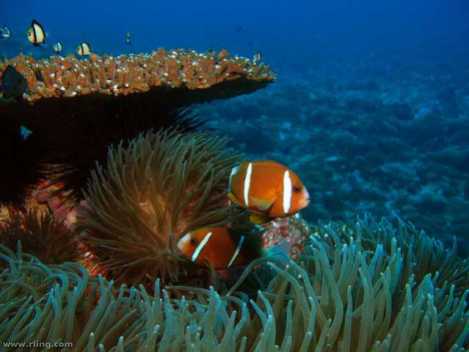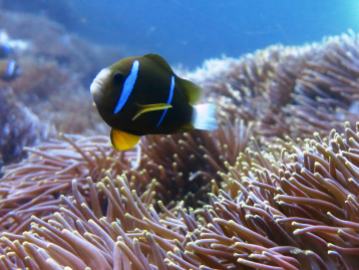Common Name: Australian Akindynos Anemonefish
Scientific Name: Amphiprion akindynos Allen, 1972
Distribution: Capricorn Reefs to Solitary Islands (as far south as Broughton Island). Possibly at some of the southeastern islands of the Coral Sea (Frederick, Kenn, Saumarez, Wreck, and Cato Reefs). Rare waifs reported from Lord Howe Island and might also be expected at Elisabeth and Middleton Reefs.
Type Locality: One Tree Island, Queensland, Australia
Identification: Caudal fin white and truncate. Two thin stripes; the anterior stripe usually broken dorsally in mature specimens. Body colored a dark russet-brown. Dorsal fin usually concolorous with the body, sometimes appearing slightly yellowed. Ventral fins usually noticeably yellowed; the anterior edge of the pelvic fins dark.
Similar: Easily confused with Amphiprion cf clarkii “Barrier Reef” from the Great Barrier Reef. The overall colors and patterns are roughly the same, but A. akindynos typically has far thinner stripes, with the anterior stripe usually broken dorsally. The dorsal fin is also usually noticeably lighter in the true Barrier Reef Anemonefish A. cf clarkii. The two likely interbreed where their ranges meet in Southern Queensland and can be expected to produce confusing hybrids. The New Caledonian A. cf akindynos is nearly identical, differing most noticeably in having darker (oftentimes nearly black) ventral fins. Amphiprion mccullochi is a darker fish and has only a single stripe, but aberrant specimens from the Australian coast are known with just a single stripe. The dark morph of A. chrysopterus can appear quite similar as well, but these usually possess a more forked or lunate caudal fin when mature. The dark morph of A. cf chrysopterus “New Guinea” has ventral fins much darker than the body, while the dark morph of A. cf chrysopterus “Vanuatu” has brown or yellowish ventral fins. Biogeography can be especially useful for identifying these confusing fishes.
Notes: A pathologically confused species which most scientific and aquarium references erroneously treat as occurring throughout Eastern Australia and east to New Caledonia. In thoroughly examining this species throughout its range, it appears this fish is primarily restricted to the subtropical Capricorn reefs and further south into New South Wales. The great similarity this fish has with the true Barrier Reef Anemonefish (A. cf clarkii) is likely due to extensive genetic introgression in the recent past. Potential mixed-species groups have been observed at Heron Island and Lady Elliot Island in the Capricorn Reefs.
The population genetics study of van der Meer 2012 is particularly germane to this discussion, as their analysis found evidence for extensive interbreeding among their samples, which included A. akindynos from the Capricorn Reefs, A. cf clarkii from the Great Barrier Reef and A. mccullochi form Lord Howe Island. However, unbeknownst to these authors, they mistakenly treated A. akindynos in the traditional broad sense and missed the most exciting find from their data—genetic evidence for the historic merging of two distantly related evolutionary lineages into a single chimeric population that is now nearly homogeneous in its phenotype. The most pressing question is whether the anemonefishes in these two regions (the Great Barrier Reef and the subtropical reefs to the south) are now actively diversifying from one another or are continuing to combine their gene pools.
The relationship of the New Caledonian A. cf akindynos to the true Australian A. akindynos is also in need of study. There is a wide geographic separation between these two regions and subtle phenotypic differences which suggest that these are worthy of separate species rank. This is in contrast to the other anemonefish endemic to this subtropical ecoregion, A. latezonatus, which shows little variation across its range.
This is a hugely abundant species in much of its range, particularly at Anemone Bay in the Solitary Islands. Aquarium specimens are uncommon, with most being misidentifications of A. cf clarkii collected near Cairns. This species’ epithet is entirely unique within scientific nomenclature, derived from the Greek ἀκίνδυνος (akindynos), meaning “free from danger”, in reference to the safety this fish enjoys when fully ensconced within its cnidocytic host.































One thought on “Amphiprion akindynos”
Comments are closed.